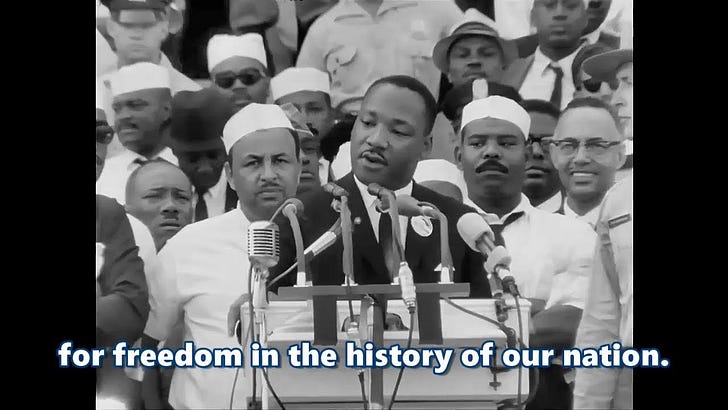Why framing matters
A common mistake many of us make when it comes to communication is the notion of “it should be obvious”, or the ubiquitous but often mistaken advice of “keep it simple stupid” aka KISS. What gets missed is that there are times when it is in fact not obvious and keeping it stupid does not help our cause.
This applies regardless of role and whether we are leading teams or persuading our managers for a raise.
To illustrate this, consider MLK’s “I have a dream speech” from August 28th 1963 in Washington DC. It’s considered by many as one of the greatest speeches of all time. I doubt we would be talking about it 6 decades later, if he had been more “business like” and “kept it simple”.
What would a 15 second “executive summary” of MLK’s speech look like? That’s exactly what the following passage considers:
King’s speech was delivered on the steps of the Lincoln Memorial and begins with a powerful allusion to the sixteenth president of the United States “in whose symbolic shadow we stand today.” King’s use of metaphor was masterful, as when he spoke of slaves “seared in the flames of withering injustice,” their lives “crippled by the manacle of segregation and chains of discrimination.”
He deftly used an extended metaphor when referring to coming to the nation’s capital to “cash a check” for equal rights. He spoke of the Bible and founding fathers’ texts like the U.S. Constitution and Declaration of Independence. Phrases like the desire to be judged by the “content of [one’s] character” would find their way into the speeches of countless others to follow.
Finally, King repeated key phrases for dramatic appeal, thus delivering among the most remembered lines of the speech. “I have a dream . . . ” and “Free at last” became signature lines, delivered in a voice that was exquisitely mournful yet hopeful at the same time.Now read leadership scholar Keith Grint’s “executive summary” of King’s speech:
It’s been a hundred years since we were promised freedom and we still haven’t got it. This state of affairs cannot continue. We must not sink to violent tactics but we want freedom now. This isn’t just a black problem, it’s an American problem. I have a dream that one day we will achieve our rights. Everyone go home and keep up the good work.
The point that Grint so brilliantly makes here is that a seventeen-minute speech or a fifteen-second one can deliver the same basic message, but the irony of the latter is that it is about as stimulating as an afternoon nap. Indeed, one cannot see a video of King deliver his speech and not be moved by his eloquence, passion, and crystallization of a key moment of the civil rights movement.
Unfortunately, the case for eloquence is a tough sell to many managers, who prefer a no-frills, straight-talk approach to their communications. They are functional in their language choices, and often happily so, because their attention is directed elsewhere. And for many everyday business communications, no-frills works perfectly well.
But there are other times when you need to inspire, especially as you move up in the organization and your voice projects louder and further. Rote behavior or compliance with authority just won’t do when you need to win hearts and minds.
Other times “the situation here and now” is complex, and you’ve got to help your people understand this complexity. To do all this, management scholar Karl Weick suggests cultivating “nuanced vocabularies” and “stockpiles of metaphors.” In short, you need eloquence, which you can learn by focusing on the art involved in framing.
—Gail Fairhurst in The Power of Framing
In addition to the rhetoric and language used in his speech, also worth noting is the choice of venue for the speech that played a role in how it got framed.
Most of us don’t have to be half as eloquent as MLK or give a speech in front of thousands. But our day to day interactions are what make up a bulk of the fabric of our work. Effectiveness can be as basic as being effective at conversations —effective at getting our point across and bringing people over to our side of thinking.
More importantly framing influences how people respond and what actions they take. It’s a key step in creating psychological safety as well. I took a closer look at framing from the following perspectives:
What exactly is a frame?
Different kinds of frames
Why framing matters in leadership
How to get better at framing
You can read it all in my article — Framing, leadership and psychological safety.
Reflection Questions
Do you tend to “dumb” down your ideas to make them simple?
How often do you fall into the trap of “this is so obvious, I shouldn’t have to explain it to you”?
Are you aware of what frames you used the last time you tried to persuade someone?
Could you have used a different, more effective frame?
Leader’s Library
Book
The Power of Framing by Gail Fairhurst is an under appreciated gem. It’s different from your typical business book while at the same time full of practical ideas that you can implement right away. If you are in a leadership or managerial role, or just wanting to get better at persuasion, it’s a must read.
Video
That's it for this edition. Have a great week!
– Sheril Mathews




You're conflating Keep It Simple Stupid with Keep It Short Stupid.
The simple truth of MLK's speech is that it's better served by being long as opposed to short. You've just 'framed' the argument in your favour by conflating simplicity with shortness, which is an oversimplification of a nuanced (albeit simple) rule.
Excellent read!